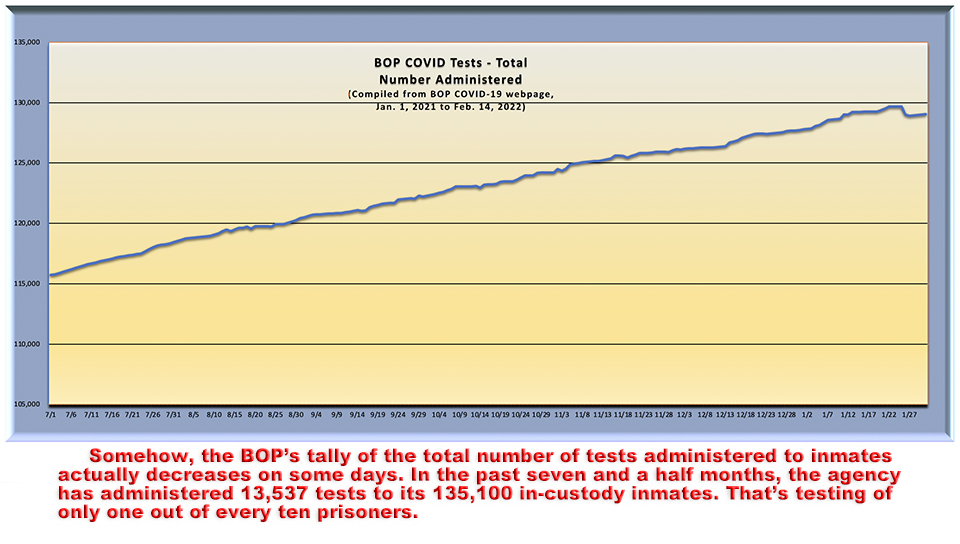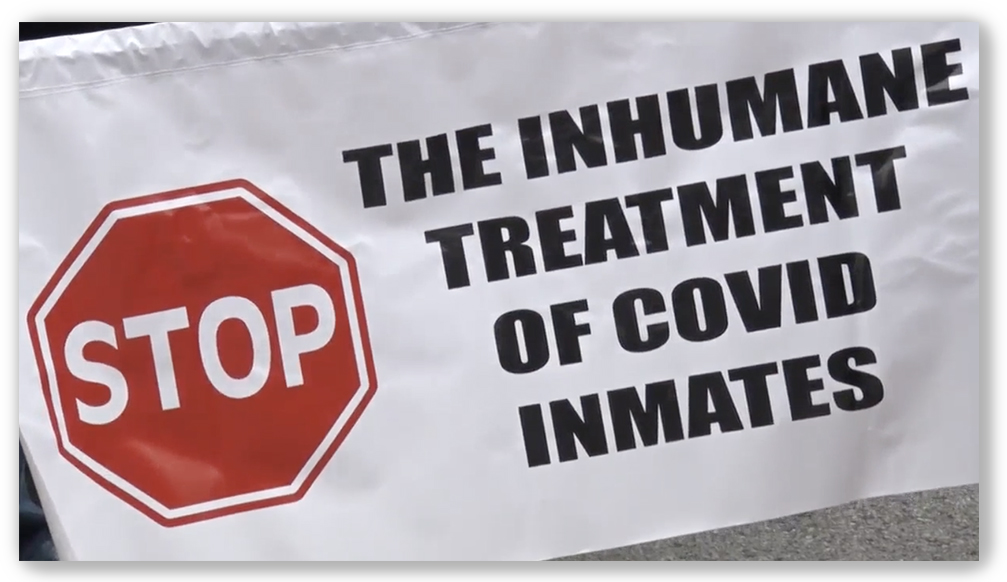We post news and comment on federal criminal justice issues, focused primarily on trial and post-conviction matters, legislative initiatives, and sentencing issues.

BOP DECLARES COVID RECOVERIES AS MEDIA BLAST MANAGEMENT
The BOP declared another 2,800 inmates cured last week, declaring at week’s end that 1,717 prisoners and 1,415 staff still have the virus. As of last night, the number was down to 1,257 inmates and 1,397 staff. The BOP is reporting COVID at 125 facilities. The agency reported no new deaths.
 There isn’t a lot of reason to trust the BOP’s stats. For instance, 2,500 inmates “recovered” over Valentine’s Day weekend, but from the following Wednesday to Friday, only two more were cured. Over last weekend, another 450 were healed. But yesterday, only one was cured. As of last Tuesday, the agency had performed 129,251 COVID tests on inmates since 2020, but as of last night, only 128,895 had been done. The number of tests waiting to be processed was 94 for 10 days in a row ending a week ago Tuesday and has been 136 every day since. For the same period a year ago, the number was never the same from February 5 through February 24, fluctuating between a high of 1,131 and a low of 695.
There isn’t a lot of reason to trust the BOP’s stats. For instance, 2,500 inmates “recovered” over Valentine’s Day weekend, but from the following Wednesday to Friday, only two more were cured. Over last weekend, another 450 were healed. But yesterday, only one was cured. As of last Tuesday, the agency had performed 129,251 COVID tests on inmates since 2020, but as of last night, only 128,895 had been done. The number of tests waiting to be processed was 94 for 10 days in a row ending a week ago Tuesday and has been 136 every day since. For the same period a year ago, the number was never the same from February 5 through February 24, fluctuating between a high of 1,131 and a low of 695.
A reasonable person could conclude that the stats are being made up.
But does it matter? After all, COVID is finally over. Or maybe not, as COVID variant BA.2 vies with Vladimir Putin for headlines.
In other news, if the BOP ever enjoyed a media honeymoon on its COVID management, that time has passed. CNN last week savaged the BOP’s COVID response in a story based on inmate deaths at FPC Alderson:
The deaths of… three women imprisoned in West Virginia reflect a federal prison system plagued by chronic problems exacerbated by the pandemic, including understaffing, inadequate medical care, and few compassionate releases. The most recent statistics from the Federal Bureau of Prisons report 284 inmates and seven staff members have died nationwide because of covid since March 28, 2020. Medical and legal experts say those numbers are likely an undercount, but the federal prison system lacks independent oversight… The Alderson inmates and their families reported denial of medical care, a lack of covid testing, retaliation for speaking out about conditions, understaffing, and a prison overrun by covid. Absences by prison staff members sickened by the virus led to cold meals, dirty clothes, and a denial of items like sanitary napkins and clean water from the commissary… In an email, BOP spokesperson Benjamin O’Cone said the agency does not comment on what he called “anecdotal allegations.”
So the BOP manipulates the stats, and it ignores the anecdotes. Controlling the information and disparaging the information you can’t control – it’s the BOP’s mission statement.
 Meanwhile, Oregon Public Broadcasting continues its coverage of a suit against the BOP brought by FCI Sheridan inmates, reporting that “dire conditions inside the federal prison in Sheridan, Oregon, have not improved over the course of the pandemic and numerous medical requests from inmates inside the facility continue to go unaddressed, according to Lisa Hay, Oregon’s federal public defender, in a recent filing. “What’s most dismaying to me is that we’re hearing the same kinds of complaints for two years and I feel somewhat helpless,” Hay told OPB in an interview a week ago. “People are dying, people are being harmed, people are being harmed psychologically and physically.”
Meanwhile, Oregon Public Broadcasting continues its coverage of a suit against the BOP brought by FCI Sheridan inmates, reporting that “dire conditions inside the federal prison in Sheridan, Oregon, have not improved over the course of the pandemic and numerous medical requests from inmates inside the facility continue to go unaddressed, according to Lisa Hay, Oregon’s federal public defender, in a recent filing. “What’s most dismaying to me is that we’re hearing the same kinds of complaints for two years and I feel somewhat helpless,” Hay told OPB in an interview a week ago. “People are dying, people are being harmed, people are being harmed psychologically and physically.”
“The system of care at the FCI Sheridan does not allow for adequate access to care,” Michael Puerini, M.D., a corrections medical care expert, stated in an inspection report filed last month. “Access to care is a fundamental aspect of the care system. Without access to care, adults in custody are essentially left without healthcare, much to their peril.”
Puerini wrote that “The Sheridan facility, at the time of our visit in September, was not following CDC guidelines regarding care of Covid patients in that patient who had tested positive for Covid were not being checked on a daily basis, as specified in the guidelines.”
CNN, Covid-19 rips through West Virginia women’s prison as federal agency takes heat (February 18, 2022)
Wall Street Journal, Fast-Spreading Covid-19 Omicron Type Revives Questions About Opening Up (February 23, 2022)
Oregon Public Broadcasting, Inmates at Oregon’s only federal prison report dire medical care (February 11, 2022)
Status Report, Stirling v. Salazar, Case No. 3:20-cv-00712 (February 4, 2022, ECF 98)
– Thomas L. Root

























